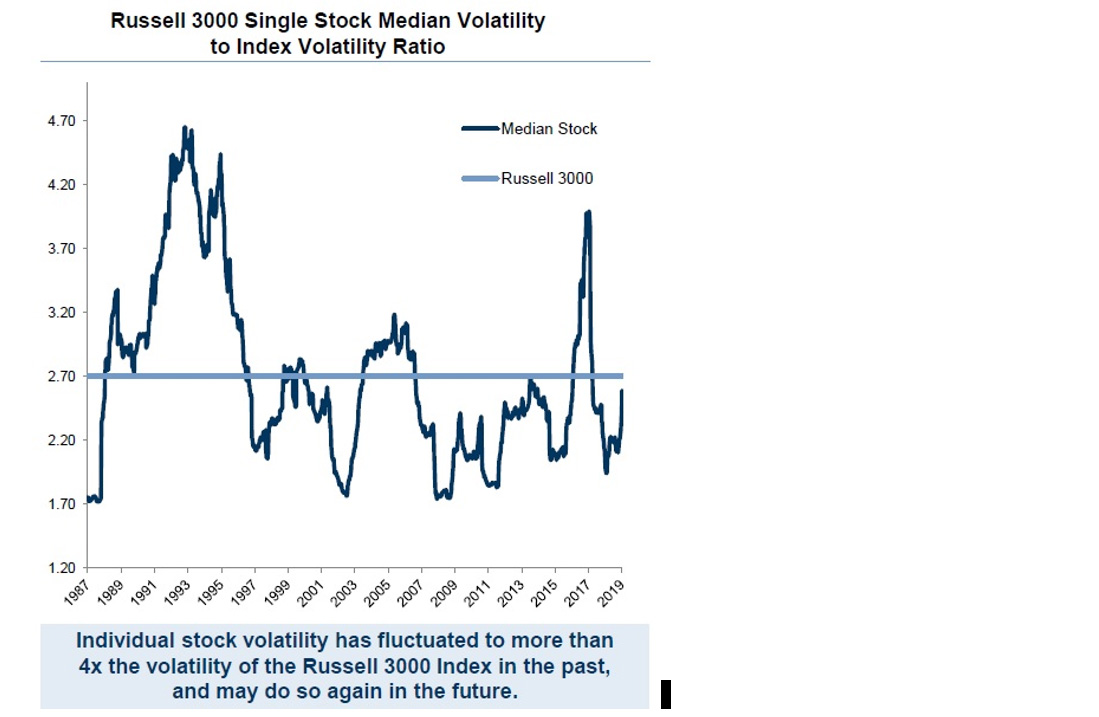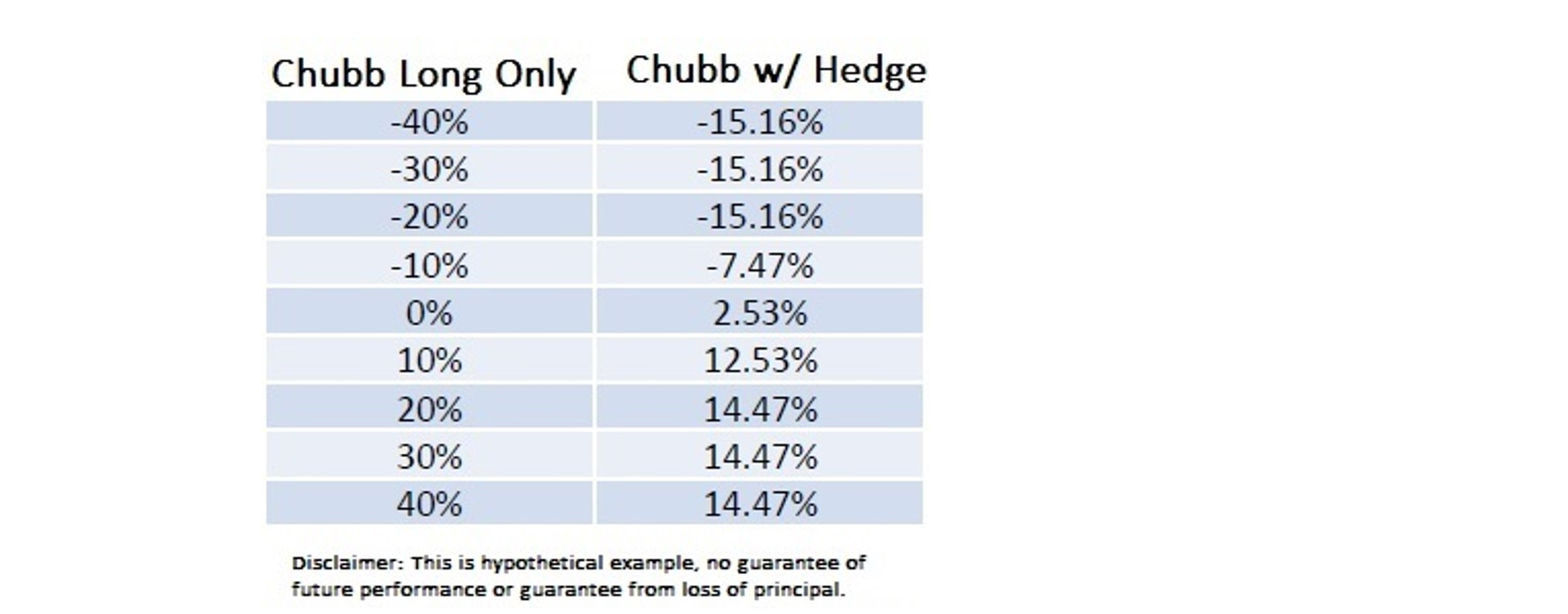4 Ways to Dilute a Concentrated Stock Risk
For investors, it’s possible to have too much of a good thing, and it can be disastrous to have too much of a bad thing. Is your portfolio overweighted in a single stock? Here’s how to tell and some strategies to help regain your balance.


Investors may have seen a large run-up in their technology stocks. Stocks like Apple, Facebook, Google and Amazon all have had a great run. However, there is a reason for the saying “Don’t put all your eggs in one basket.” It may have something to do with the risk of owning too much of one stock.
According to a recent Goldman Sachs Asset Management study, 23% of the stocks in the Russell 3000 Index (a broad measure of the U.S. stock market) lost more than a fifth of their value in an average calendar year from 1986-2019. The study found the average stock was more than three times as volatile as the Russell 3000 index itself (Source: FactSet, GSAM).

Disclaimer
Source: Goldman Sachs Asset Management
Given the research from Goldman Sachs, investors with a large concentration in one stock may be on a wild and risky ride in the years ahead.

Sign up for Kiplinger’s Free E-Newsletters
Profit and prosper with the best of expert advice on investing, taxes, retirement, personal finance and more - straight to your e-mail.
Profit and prosper with the best of expert advice - straight to your e-mail.
Volatility is a measure of risk, or how much the stock price fluctuates. If a single stock is more than three times as volatile as the index, brace yourself for a wild ride. Volatility on the upside is a good thing. Negative volatility, or price decreases — as in case of Boeing, which is down 38% in the past year — can lead to steep losses (Source: Morningstar). That is why investment advisers preach diversification. Spreading the risk around different stocks can mitigate the effects any one stock has on the whole portfolio.
How Much Is Too Much of One Stock?
Despite research to the contrary, some investors are overweighted to one stock. When one stock is more than 10% of the portfolio, we call this a concentrated stock position, and a red flag goes up. There may be several reasons for the concentrated stock position. Some can't sell their company stock due to employer restrictions. Others don't want to pay the income tax on the gain. Some think the stock may go higher.
Investors should not underestimate the risk of owning too much of one stock – see Lehman Brothers, WorldCom, Enron, Pier One, Frontier Communications and Hertz to name a few examples.
What to Do about an Overweighted Portfolio
If you are concerned about the risk one large stock position has on your retirement nest egg (as you should be), here are four solutions to consider:
Gift Shares to Charity
Gifting stock to a qualified charity is one idea. Donating appreciated shares allows you to get rid of the stock and not incur the tax from selling. You want to gift the shares with the lowest cost-basis or the largest taxable gain.
Sell with Tax-Loss Harvesting in Mind
Before you sell the stock, see if you can use losses in other parts of the portfolio to offset the taxable gain. We call this tax-loss harvesting. This can only be done in non-retirement accounts. We manage several portfolios that actively harvest losses throughout the year when they come up. We try to match the harvested losses to the gain incurred from selling the concentrated stock position. This helps reduce the net taxable gain at the end of the year. The smaller the taxable gain, the less tax owed, which is a good thing.
Taxpayers can also deduct $3,000 of losses from their federal taxable income each year. Unused losses are carried forward to future years on your federal tax return, and some states may allow you to carry forward unused losses on your state tax return as well.
Exchange Fund
For more sophisticated and wealthy investors, an Exchange Fund swaps your stock for a pool of diversified stocks. Since it is a swap, and not a sale, there is no immediate income tax due. The benefit is the new pool of stocks provides greater diversification. Exchange Funds are relatively new, available only to Qualified Purchasers (defined as those with investable assets greater than $5 million) and illiquid — generally a seven-year lock-up.
Zero-Cost Collar

Investors can also use options to mitigate the downside of a stock's loss. One strategy is a "zero-cost collar." A zero cost-collar involves writing a call option — selling a call — and using the income to buy a put option on the underlying stock. Buying the put option gives you the right to sell the stock at a predetermined price. That comes in handy if the stock price drops. Writing the call option provides income to buy the put option, hence the "zero-cost."
It doesn’t always work out to a zero-cost, but it is usually close. The figure above illustrates a collar strategy with Chubb Stock (ticker symbol CB). Remember: Options involve risk, are complicated, and can reduce your upside. It's best to consult with an experienced professional before implementing.
The Biggest Risk
The biggest risk, in my opinion, is not having a plan to deal with a concentrated stock position. Letting the years go by without doing anything only complicates the problem. The stock position may get larger and the tax bill higher. In my opinion, a diversified portfolio should not have more than 10% of the assets in any one stock.
Luckily, as described above, there are several ways to manage a large stock position in a tax-efficient and smart way. It all starts with a plan.
Disclaimer
The views and opinions expressed in this article are solely those of the author and should not be attributed to Summit Financial LLC. Investment advisory and financial planning services are offered through Summit Financial, LLC, an SEC Registered Investment Adviser, 4 Campus Drive, Parsippany, NJ 07054. Tel. 973-285-3600 Fax. 973-285-3666. This material is for your information and guidance and is not intended as legal or tax advice. Legal and/or tax counsel should be consulted before any action is taken.
Disclaimer
Investment advisory and financial planning services are offered through Summit Financial LLC, an SEC Registered Investment Adviser, 4 Campus Drive, Parsippany, NJ 07054. Tel. 973-285-3600 Fax. 973-285-3666. This material is for your information and guidance and is not intended as legal or tax advice. Clients should make all decisions regarding the tax and legal implications of their investments and plans after consulting with their independent tax or legal advisers. Individual investor portfolios must be constructed based on the individual’s financial resources, investment goals, risk tolerance, investment time horizon, tax situation and other relevant factors. Past performance is not a guarantee of future results. The views and opinions expressed in this article are solely those of the author and should not be attributed to Summit Financial LLC. Links to third-party websites are provided for your convenience and informational purposes only. Summit is not responsible for the information contained on third-party websites. The Summit financial planning design team admitted attorneys and/or CPAs, who act exclusively in a non-representative capacity with respect to Summit’s clients. Neither they nor Summit provide tax or legal advice to clients. Any tax statements contained herein were not intended or written to be used, and cannot be used, for the purpose of avoiding U.S. federal, state or local taxes.
Get Kiplinger Today newsletter — free
Profit and prosper with the best of Kiplinger's advice on investing, taxes, retirement, personal finance and much more. Delivered daily. Enter your email in the box and click Sign Me Up.

Michael Aloi is a CERTIFIED FINANCIAL PLANNER™ Practitioner and Accredited Wealth Management Advisor℠ with Summit Financial, LLC. With 21 years of experience, Michael specializes in working with executives, professionals and retirees. Since he joined Summit Financial, LLC, Michael has built a process that emphasizes the integration of various facets of financial planning. Supported by a team of in-house estate and income tax specialists, Michael offers his clients coordinated solutions to scattered problems.
-
 Stock Market Today: Stocks Struggle Amid Tariff Uncertainty
Stock Market Today: Stocks Struggle Amid Tariff UncertaintyBoeing dropped after China suspended new aircraft orders, while Bank of America and Citi climbed on earnings beats.
By Karee Venema
-
 Starbucks 2025 Dress Code Changes: See the New Look
Starbucks 2025 Dress Code Changes: See the New LookThe 2025 Starbucks dress code change features a uniformed look as part of creating a more familiar and friendly cafe experience.
By Sean Jackson
-
 Should You Hire a Public Adjuster for Your Insurance Claim?
Should You Hire a Public Adjuster for Your Insurance Claim?As natural disasters strike more often, insurance clients are asking, 'What should I do, or who should I hire, if my insurance company is jerking me around?'
By H. Dennis Beaver, Esq.
-
 Tips to Help Entrepreneurs Create Self-Sustaining Businesses
Tips to Help Entrepreneurs Create Self-Sustaining BusinessesWith the right processes and people in place, a truly sustainable business can be efficiently passed on to a successor and run profitably on its own.
By Jason L Smith, CEP®, BPC
-
 Navigating Annuity Taxation: A Guide for Financial Advisers
Navigating Annuity Taxation: A Guide for Financial AdvisersUnderstanding the essentials of taxation in retirement income strategies involving annuities helps ensure positive outcomes for clients.
By Jake Klima
-
 How Google Reviews Can Help (or Hurt) Financial Advisers
How Google Reviews Can Help (or Hurt) Financial AdvisersDon't leave your Google Business Profile unclaimed — someone else can make changes if they claim it. Also, here's what you can (and cannot) do with the reviews.
By Jeff Briskin
-
 How Baby Boomers and Gen Xers Are Redefining Retirement Living
How Baby Boomers and Gen Xers Are Redefining Retirement LivingBoth generations need to embrace change and leverage real estate as a dynamic asset in their retirement planning. Here's how financial advisers can help, too.
By David Conti, CPRC
-
 How Good Advisers Manage Risk in Challenging Markets
How Good Advisers Manage Risk in Challenging MarketsThey understand the difference between what might be real challenges to an investor's strategy and fear brought on by market volatility.
By Ryan L. Kirk, CFA®
-
 Financial Planning's Paradox: Balancing Riches and True Wealth
Financial Planning's Paradox: Balancing Riches and True WealthWhile enough money is important for financial security, it does not guarantee fulfillment. How can retirees and financial advisers keep their eye on the ball?
By Richard P. Himmer, PhD
-
 A Confident Retirement Starts With These Four Strategies
A Confident Retirement Starts With These Four StrategiesWork your way around income gaps, tax gaffes and Social Security insecurity with some thoughtful planning and analysis.
By Nick Bare, CFP®